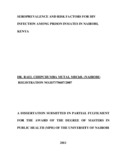| dc.contributor.author | Mutai, Rael C | |
| dc.date.accessioned | 2016-05-20T16:15:12Z | |
| dc.date.available | 2016-05-20T16:15:12Z | |
| dc.date.issued | 2011 | |
| dc.identifier.uri | http://hdl.handle.net/11295/95800 | |
| dc.description.abstract | Background: HIV infection among prison inmates shows one of the highest prevalence rates
for specific population subgroups, reaching as high as 17% in Brazil and elsewhere in the
world.Published data on HIV infection in correctional facilities in Kenya is scarce. This study
set out to establish the sero-prevalence and risk factors for HIV infection among prison
inmates in Nairobi, Kenya.
Methodology: This was a cross-sectional study conducted between March and April, 2010.
Using simple random sampling, 399 participants were selected. A standardized personal riskfactor
questionnaire was then administered and rapid tests for HIV antibodies were carried out
for 389 prison inmates as ten inmates declined the HIV test. These were drawn from the four
short and medium term prisons (overall population: 4,930) situated within Nairobi province.
Of the 389 prisoners tested, the sex composition was male (86.9%) and female (13.1%)
inmates. Samples were analyzed for HIV using Determine HIV1/2TM rapid test kit. Specimens
initially reactive for HIV were retested with Bioline HIV1/2TM rapid test kit. Data were
analyzed using SPSS version 14.0 and P values ≤ 0.05 were considered significant.
Results: Of the 389 subjects, 25 (6.4 %) tested positive for HIV. Women and those aged
above 30 years were more likely to be infected with HIV, with the highest prevalence in the
35-44years age group. The respondents perceived the risk of contracting HIV infection to be
four times higher before prison than in prison. Condom use was reported to be low both before
and during incarceration and the acceptability of condom distribution in prison was found to
be low (16.4%). Associated risk factors for HIV infection included ignorance of transmission
modes, ignorance of prevention modes, illiteracy and injection drug use. A small proportion of
inmates injected drugs at 3.1% before prison and 0.3% in prison.
Conclusions: The study confirms the presence of HIV infection in prison with an overall seroprevalence
of 6.4% which is lower than the national average of 7.4%. This low HIV
prevalence may be attributed to the low prevalence of injection drug use among prison
inmates, the increased perception of the HIV risk among prison inmates and possibly due to
the fact that these were predominantly short and medium term prisoners and therefore more
reflective of the HIV prevalence in the community rather than the prison system.
Majority of the inmates were HIV Sero-negative with self-reported high-risk behaviors. This
indicates that prisoners are a vulnerable group and require special attention when addressing
the needs of the most at risk populations in HIV programs. The study did not confirm
homosexual contact among prisoners. This is possibly due to stigma associated with the issue.
Prevalence of Injection drug use was very low. Uptake of HIV testing was low and there were
notable gender differences in HIV testing; with women being more likely to have tested for
HIV both before and during incarceration.
HIV preventive and treatment services were available on a small scale to the inmates;
however, condom distribution was unavailable to inmates due to legal and moral barriers.
Recommendations: There is need for collaboration between KPS, academic institutions and
policy makers to develop policies that will contribute towards minimizing HIV transmission
and sustain the current low HIV prevalence within the prison. Kenya Prisons Service should
provide easy access to voluntary HIV testing and counseling for inmates to increase testing
uptake and provide linkage to treatment services. The HIV comprehensive education program
for inmates should also be strengthened as the benefits have been demonstrated. Further
research should be conducted to establish the magnitude of HIV/AIDS and associated risk
factors in prison. | en_US |
| dc.language.iso | en | en_US |
| dc.publisher | University of Nairobi | en_US |
| dc.rights | Attribution-NonCommercial-NoDerivs 3.0 United States | * |
| dc.rights.uri | http://creativecommons.org/licenses/by-nc-nd/3.0/us/ | * |
| dc.title | Seroprevalence And Risk Factors For Hiv Infection Among Prison Inmates In Nairobi, Kenya | en_US |
| dc.type | Thesis | en_US |
| dc.description.department | a
Department of Psychiatry, University of Nairobi, ; bDepartment of Mental Health, School of Medicine,
Moi University, Eldoret, Kenya | |



